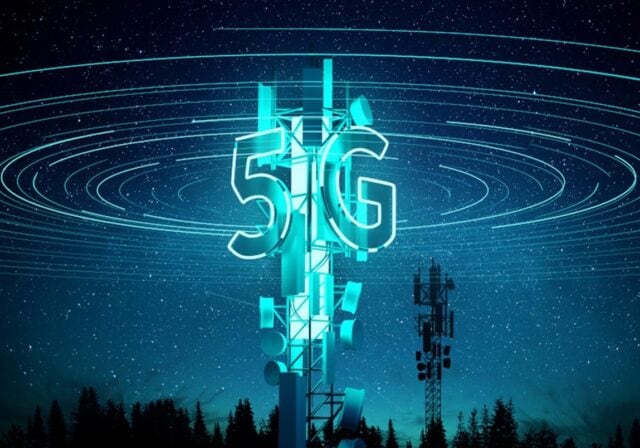5G is the latest in a line of network standards (1G, 2G, 3G, 4G, and now, 5G) and it’s been the key to delivering the high-speed, low-latency connectivity needed to keep nearly everything running smoothly—including our computers, laptops, phones, and internet of things (Iot) devices like connected appliances, doorbells, app-controlled lights, voice assistants, security systems and so much more. It’s allowed us to free ourselves from the cable and wires, while also staying connected unlike any other time in history.
For those of you who want to take a slightly deeper dive into 5G network architecture to see how the design powers the next generation of wireless, here’s a broad overview of how it all comes together.
5G network architecture is divided into three main parts: User Equipment (UE), the Radio Access Network (RAN) and the Core Network. Here’s a breakdown:
- User Equipment (UE). This is the easy part. It simply refers to things like smartphones, tablets, laptops, IoT devices, and any devices that connect to the network. 5G-capable devices have on-board chipsets that support advanced features and multiple frequency bands (low, mid, and high), which we’ll discuss in the next section.
- Radio access network (RAN). This is the part of the network that directly communicates with the User Equipment mentioned above. It includes base stations with the antennas needed to increase capacity and throughput (the amount of data that can pass through a network at the same time), as well as the radio interfaces that connect devices to the core network. Let’s take a quick look at each frequency band and the role each plays in keeping you connected:
- 5G low-band (frequencies <1 GHz)
- Can travel long distances
- Able to penetrate obstacles like buildings, walls, metal, foliage, etc.
- Reliable indoor coverage
- Less susceptible to interference compared to higher bands
- Challenges: Lower data capacity/slower data rates; struggles to support high-bandwidth applications like video streaming, online gaming & cutting-edge technologies
- 5G mid-band (frequencies spanning 1 GHz - 6 GHz)
- Travels through obstacles
- Good data rates compared to low-band
- Higher data capacity compared to low-band
- Good for supplementing coverage for things like video streaming, gaming, and high-speed internet access
- Challenges: Susceptible to interference; Limited data capacity compared to millimeter-wave (mmWave), which we’ll cover next
- 5G high-band (mmWave frequencies)
- Support for a large number of connected devices; IoT ecosystem
- Enables faster data transfer rates and advanced applications needing high-speed data transmission
- Reduced latency (the time it takes for data to travel between devices)
- Good for densely populated urban areas where network congestion is a concern
- Challenges: Permeating buildings, thick walls, metal infrastructure & other obstacles
- 5G low-band (frequencies <1 GHz)
- Core Network. This is the central part of 5G network architecture, and it manages the overall network, providing various services and ensuring connectivity between two different parts of the network: Standalone and Non-Standalone.
- 5G Standalone (SA). This is the part of the 5G network core that doesn’t rely on the low-band or mid-band spectrum (e.g., 4G) to anchor the connection. The 5G core can deliver incredibly fast speeds because it offers massive capacity. However, as we pointed out earlier, high-band doesn’t always travel very well through obstacles. T-Mobile was the first in the world to roll out nationwide 5G SA and it’s already helping to expand the 5G coverage capacity, data speeds, and lower latency needed to help 5G reach its full potential. Right now, however, it works in tandem with 5G NSA, which is the second part of the core network.
- 5G Non-Standalone (NSA). T-Mobile utilizes its reliable 4G LTE network to supplement coverage. This is referred to as the non-standalone core. Why is it needed? It solves the SA issue mentioned above, and it offers coverage in areas where 5G is unavailable, like in very rural areas or other places without a lot of 5G infrastructure. Plus, some people still use older phones and devices that aren’t 5G capable. This provides coverage for those, as well.
A strong core network, which is at the center of 5G network architecture, requires a multi-band spectrum strategy, using low-band to blanket the country and mid-band and high-band to deliver faster speeds to nearly everyone.
You may also be interested in:
Ookla® Speedtest® awards T-Mobile as the Best Mobile Network in the U.S.
Sources:
https://www.digi.com/blog/post/5g-network-architecture
https://www.geeksforgeeks.org/5g-network-architecture
https://www.t-mobile.com/business/resources/articles/5g-spectrum-frequency-bands
https://www.t-mobile.com/news/network/t-mobile-revs-up-millimeter-wave-with-5g-standalone
https://www.gartner.com/en/information-technology/glossary/throughput





